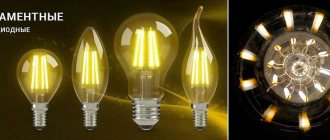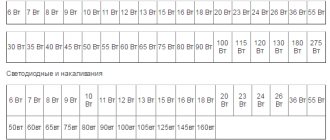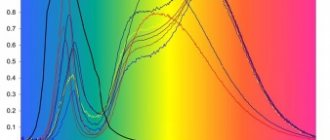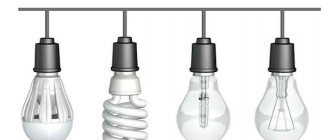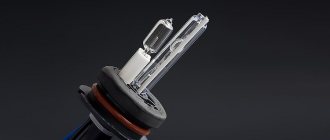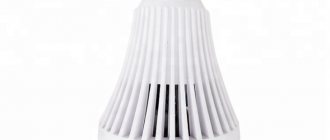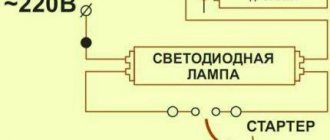LED lamps seem to be finally replacing traditional light sources. Consumers are increasingly choosing LED lamps for their efficiency and long service life, and new models that differ in many parameters regularly appear on store windows. Let's try to understand the main characteristics so as not to make a mistake when buying a lamp.
Base
The first thing you need to pay attention to is what base the lamp you need has, because if you make a mistake, you simply won’t be able to insert the lamp into the lamp. There are several types of LED lamp bases on the market, which can be “identified” by the markings on the packaging. The letters in the name of the base indicate its type, and the numbers indicate the diameter for screw bases or the distance between the contacts for pin bases.
Base E27
The most common type of base is a screw base, or, as it is also called, an “Edison base.” Screw bases come in three sizes:
- E27 - standard base. It is used everywhere in household lighting.
- E14 - “minion”. It has a small diameter. Lamps with it are often used in pendant lamps.
- E40 is a large diameter base, also called “Goliath”. It is found in the design of the most powerful lamps for street and industrial lamps: 50, 80, 100, 150 W.
Pin sockets
Less common, but gaining more and more popularity. Such bases can differ greatly from each other, but all of them are not screwed in, but inserted into the lamp, which ensures maximum simplicity and safety of their operation. A complete replacement for halogen lamps are the corresponding LED lamps with pin sockets: GU10, GU5.3, G4, G9, GX53, GX70 and G13. The most common bases on the market are GU5.3 and GU10. They are equipped with MR16 and PAR16 type spotlights, which are used for accent and spot lighting in ceiling lamps.
G4 and G9 sockets are most often equipped with compact capsule lamps, which are used in decorative lighting, furniture and ceiling lamps, stretch ceilings, etc. GX53, GX70 - the base of the so-called “tablets” or “spots” - lamps made in the shape of a flat cylinder. They are used for general and decorative lighting of residential premises: in suspended ceilings, lighting niches and furniture.
G13 is the base of linear T8 LED lamps, which are suitable for illuminating large audiences, for example in a school or office, as well as shops and hospitals.
Advantages and disadvantages
LED lighting, like any other technology, has its own advantages and disadvantages that you should definitely know about.
pros
- economical energy consumption;
- can be connected to a dimming system;
- long service life (from 3 to 8 years);
- environmental friendliness.
Minuses
- the parameters indicated on the packaging may not match;
- quite high cost;
- low quality of parts (especially diodes).
Color of light
LED lamps, unlike incandescent lamps, can have different glow colors. Therefore, it is important to decide where the lamp will be used and what color is suitable in this case: warm, neutral or cold.
Warm light, similar to that produced by an incandescent lamp, has a color temperature of ~3000 K. Warm light lamps are optimal for an apartment (living room, bedroom, kitchen). They are indispensable for lighting recreation areas, as they provide the most comfortable light for the eyes.
When organizing lighting in offices, educational institutions and medical institutions, lamps with a color temperature of ~4000 K (neutral white light) are used. Lamps with a color temperature of ~6500 K (cool white) allow you to concentrate on your work and better distinguish details. They are used in production and office spaces.
Power and luminous flux
Power
To keep the room dark, it is important to choose a lamp of the required power. Most often, LED lamps with a power of 3 to 25 W are found on sale. Some brands, for example, IEK®, also have more powerful models - 30, 50 and even 100 and 150 W.
It is believed that on average, at the same brightness, 1 W of an LED lamp replaces 8 W of an incandescent lamp (see Table 1 ). In other words, a 15W LED bulb produces the same amount of light as a 120W incandescent bulb, and uses eight times less electricity!
Table 1. Comparative power of lamps of different types with equal luminous flux (W)
| LED lamps | Halogen lamps | Incandescent lamps |
| 3-5 | 9-15 | 25-40 |
| 7-9 | 15-25 | 60-75 |
| 11-13 | 25-50 | 75-100 |
Brightness
The brightness of an LED lamp is characterized by luminous flux, which is measured in lumens (lm). The higher the power of the lamp, the greater the luminous flux it can produce. The exact luminous flux value must be indicated on the lamp packaging.
To create the correct lighting, it is better to familiarize yourself with the recommendations of SNiP 23-05-95 “Natural and artificial lighting” and check the data on the packaging. The most important lighting standards are presented in Table 2 .
Table 2. Illumination standards
| Room type | Illumination standard (lm/m2) |
| Bedroom, kitchen | 150 |
| Children's room | 200 |
| Bathroom, toilet | 150 |
| Classrooms in schools | 500 |
| Audiences in technical schools and universities | 400 |
| General office | 300 |
| Drawing office | 500 |
But light bulbs are expensive
Fans of the archaic may object to me that LED lamps are quite expensive to produce and, accordingly, it will not be possible to buy them for the same money as an incandescent lamp. And they will undoubtedly be right. But not really.
The fact is that if LED lamps at first really frightened people with their unusually high cost, now they are approaching the cost of incandescent lamps. At least, when you look at a store shelf, you no longer want to fall and kick your leg.
If you make an appropriate selection, for example, on Yandex . Market , it turns out that the picture is not so terrible. For example, LED lamps from domestic and Chinese manufacturers cost about 50-60 rubles apiece . Thus, if I needed to completely update the fleet of light bulbs at home, I would spend about 1000 rubles . Although, of course, this is rarely done, usually the lamps are replaced as they burn out.
Of course, the simplest incandescent lamp is incomparably cheaper - you can buy it for 10-20 rubles .
Therefore, about 800 must be subtracted . Let's subtract even a thousand, because you don't plan to buy the cheapest LED lamps. So, 9500 - 1000 = 8.5 thousand rubles.
There is one more point that needs to be taken into account. This is the lifespan of the lamp . The average lifespan of an incandescent lamp is about 1000 light hours . Thus, we would need 36 incandescent lamps (we spent 360 rubles ). But this figure for an LED lamp is really impressive. Its burning life is about 11,000 hours , that is, according to our calculations, in 4 years we will not need to change a single lamp - of course, provided that the conditions of their use comply with the recommended ones. 360 rubles were crossed out .
Bulb, LED and filament thread
The light source in the lamp can be a spot LED or a filament thread:
- Filament thread is one of the most effective light sources. Externally, filament lamps resemble incandescent lamps. High aesthetic characteristics make them the most popular among buyers. Such lamps do not dazzle even with a transparent bulb and are widely used both in household lighting fixtures and in decorative design lighting.
- LED is a point and very bright light source. If an LED lamp is visible in a chandelier or lamp, then with a transparent bulb the light may be too harsh. In this case, it is better to use a lamp with a frosted bulb, which will provide even and soft light. Lamps with a transparent bulb are best used in shades where they are not visible.
LEDs can only shine in front of themselves, so not only their number is important, but also their location, as well as the shape of the bulb. The dispersion angle will directly depend on this. To create ideal lighting in a room, you will need different lamps: both with a wide angle of dispersion and directional light.
For a chandelier, it is better to take light bulbs with open bulbs: “ball”, “pear” and “candle” shapes, as well as “candle in the wind”. Their dispersion angle is quite large (170-180°), which allows them to illuminate the entire room. The scattering angle of a filament lamp is even greater - up to 360°.
Lamps with directional light (MR16, PAR16) are used in spotlights and track lamps, spots, sconces, decorative and furniture lighting, and suspended ceilings.
Thanks to lamps with different scattering angles, you can organize the lighting of the room, for example, in this way:
- In the center there is a chandelier that illuminates the entire room.
- Sofas or beds have a pair of directional lamps or sconces.
- We illuminate the paintings with spots.
- We insert spotlights and an LED strip into the plasterboard structure on the ceiling.
Life time
One of the advantages of LED light sources over incandescent lamps is their durability. When used properly, IEK® LED lamps will last a minimum of 30,000 hours. Warranty period - 2 years.
If we assume that the lamp will shine every day for eight hours, then it will last for ten years of service. During this time, we would have to replace dozens of incandescent lamps and pay eight times more for electricity. The amount invested in the purchase of an LED lamp justifies itself many times over.
What types of LED lamps are there?
To correctly select such lamps, it is necessary, first of all, to decide on some important parameters, such as:
- what kind of light source they will serve (main, additional);
- what is the lighting area;
- what shade of light should be;
- what is the purpose of the room?
Note that lamps for household use can be based on the type of base
- E14/E27 . These connection options are the most common. The number in the designation says what the diameter of the spiral is (mm), and the letter E indicates that Edison invented them;
- G9 . They differ in that the connection occurs through a two-pin connector (with a 9 mm distance between the pins).
LED lamps can also be classified according to their shape :
- traditional (represent candles, pears or flasks);
- corn - a diode circuit is located around the perimeter of the cylinder.
Finally, you can classify by type of control and sensors :
- models with motion/light sensor;
- rechargeable (powered by AA batteries or, as an option, a battery);
- with remote control;
- smart models (such lamps are controlled via wi-fi; a special application is used to adjust the color and brightness of the lighting).
Advantages of LED lamps
- The service life is tens of times longer than that of incandescent and halogen lamps.
- Energy consumption is several times lower than that of other lamps - energy savings of up to 86%.
- They do not heat up, making them extremely safe to use.
- Complies with electromagnetic compatibility standards.
- They do not contain mercury and do not require special disposal.
- They light up almost instantly and quickly reach maximum brightness.
- Stable luminous flux throughout the entire service life.

